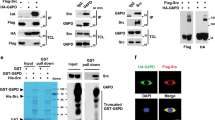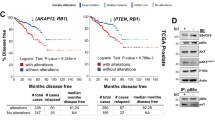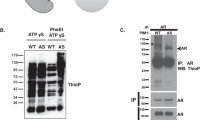Abstract
Protein tyrosine phosphatase nonreceptor type 14 (PTPN14) is frequently mutated in a variety of human cancers. However, the cell signaling pathways regulated by PTPN14 largely remain to be elucidated. Here, we identify a list of potential substrates of PTPN14 using a phospho-proteomic approach. We show that p130 Crk-associated substrate (p130Cas) is a direct substrate of PTPN14 and that PTPN14 specifically regulates p130Cas phosphorylation at tyrosine residue 128 (Y128) in colorectal cancer (CRC) cells. We engineered CRC cells homozygous for a p130Cas Y128F knock-in mutant and found that these cells exhibit significantly reduced migration and colony formation, impaired anchorage-independent growth, slower xenograft tumor growth in nude mice and have decreased phosphorylation of AKT. Furthermore, we demonstrate that SRC phosphorylates p130Cas Y128 and that CRC cell lines harboring high levels of pY128Cas are more sensitive to SRC family kinase inhibitor Dasatinib. These findings suggest that p130Cas Y128 phosphorylation may be exploited as a predictive marker for Dasatinib response in cancer patients. In aggregate, our studies reveal a novel signaling pathway that has an important role in colorectal tumorigenesis.
This is a preview of subscription content, access via your institution
Access options
Subscribe to this journal
Receive 50 print issues and online access
$259.00 per year
only $5.18 per issue
Buy this article
- Purchase on Springer Link
- Instant access to full article PDF
Prices may be subject to local taxes which are calculated during checkout







Similar content being viewed by others
References
Blume-Jensen P, Hunter T . Oncogenic kinase signalling. Nature 2001; 411: 355–365.
Brognard J, Hunter T . Protein kinase signaling networks in cancer. Curr Opin Genet Dev 2011; 21: 4–11.
Julien SG, Dubé N, Hardy S, Tremblay ML . Inside the human cancer tyrosine phosphatome. Nat Rev Cancer 2011; 11: 35–49.
Wang Z, Shen D, Parsons DW, Bardelli A, Sager J, Szabo S et al. Mutational analysis of the tyrosine phosphatome in colorectal cancers. Science 2004; 304: 1164–1166.
TCGA Integrated genomic analyses of ovarian carcinoma. Nature 2011; 474: 609–615.
Sjoblom T, Jones S, Wood LD, Parsons DW, Lin J, Barber TD et al. The consensus coding sequences of human breast and colorectal cancers. Science 2006; 314: 268–274.
Stransky N, Egloff AM, Tward AD, Kostic AD, Cibulskis K, Sivachenko A et al. The mutational landscape of head and neck squamous cell carcinoma. Science 2011; 333: 1157–1160.
Li M, Zhao H, Zhang X, Wood LD, Anders RA, Choti MA et al. Inactivating mutations of the chromatin remodeling gene ARID2 in hepatocellular carcinoma. Nat Genet 2011; 43: 828–829.
van Haaften G, Dalgliesh GL, Davies H, Chen L, Bignell G, Greenman C et al. Somatic mutations of the histone H3K27 demethylase gene UTX in human cancer. Nat Genet 2009; 41: 521–523.
Wei X, Walia V, Lin JC, Teer JK, Prickett TD, Gartner J et al. Exome sequencing identifies GRIN2A as frequently mutated in melanoma. Nat Genet 2011; 43: 442–446.
Wyatt L, Khew-Goodall Y . PTP-Pez: a novel regulator of TGFbeta signaling. Cell Cycle 2008; 7: 2290–2295.
Wadham C, Gamble JR, Vadas MA, Khew-Goodall Y . The protein tyrosine phosphatase Pez is a major phosphatase of adherens junctions and dephosphorylates beta-catenin. Mol Biol Cell 2003; 14: 2520–2529.
Ogata M, Takada T, Mori Y, Oh-hora M, Uchida Y, Kosugi A et al. Effects of overexpression of PTP36, a putative protein tyrosine phosphatase, on cell adhesion, cell growth, and cytoskeletons in HeLa cells. J Biol Chem 1999; 274: 12905–12909.
Wadham C, Gamble JR, Vadas MA, Khew-Goodall Y . Translocation of protein tyrosine phosphatase Pez/PTPD2/PTP36 to the nucleus is associated with induction of cell proliferation. J Cell Sci 2000; 113 (Pt 17): 3117–3123.
Wyatt L, Wadham C, Crocker LA, Lardelli M, Khew-Goodall Y . The protein tyrosine phosphatase Pez regulates TGFbeta, epithelial-mesenchymal transition, and organ development. J Cell Biol 2007; 178: 1223–1235.
Reynolds AB, Kanner SB, Wang HC, Parsons JT . Stable association of activated pp60src with two tyrosine-phosphorylated cellular proteins. Mol Cell Biol 1989; 9: 3951–3958.
Matsuda M, Mayer BJ, Fukui Y, Hanafusa H . Binding of transforming protein, P47gag-crk, to a broad range of phosphotyrosine-containing proteins. Science 1990; 248: 1537–1539.
Dorssers LC, van Agthoven T, Dekker A, van Agthoven TL, Kok EM . Induction of antiestrogen resistance in human breast cancer cells by random insertional mutagenesis using defective retroviruses: identification of bcar-1, a common integration site. Mol Endocrinol 1993; 7: 870–878.
Cabodi S, Tinnirello A, Di Stefano P, Bisaro B, Ambrosino E, Castellano I et al. p130Cas as a new regulator of mammary epithelial cell proliferation, survival, and HER2-neu oncogene-dependent breast tumorigenesis. Cancer Res 2006; 66: 4672–4680.
Burnham MR, Harte MT, Richardson A, Parsons JT, Bouton AH . The identification of p130cas-binding proteins and their role in cellular transformation. Oncogene 1996; 12: 2467–2472.
Honda H, Oda H, Nakamoto T, Honda Z, Sakai R, Suzuki T et al. Cardiovascular anomaly, impaired actin bundling and resistance to Src-induced transformation in mice lacking p130Cas. Nat Genet 1998; 19: 361–365.
Defilippi P, Di Stefano P, Cabodi S . p130Cas: a versatile scaffold in signaling networks. Trends Cell Biol 2006; 16: 257–263.
Flint AJ, Tiganis T, Barford D, Tonks NK . Development of “substrate-trapping” mutants to identify physiological substrates of protein tyrosine phosphatases. Proc Natl Acad Sci USA 1997; 94: 1680–1685.
Blanchetot C, Chagnon M, Dube N, Halle M, Tremblay ML . Substrate-trapping techniques in the identification of cellular PTP targets. Methods 2005; 35: 44–53.
Rush J, Moritz A, Lee KA, Guo A, Goss VL, Spek EJ et al. Immunoaffinity profiling of tyrosine phosphorylation in cancer cells. Nat Biotechnol 2005; 23: 94–101.
Zhang X, Guo C, Chen Y, Shulha HP, Schnetz MP, LaFramboise T et al. Epitope tagging of endogenous proteins for genome-wide ChIP-chip studies. Nat Methods 2008; 5: 163–165.
Montero JC, Seoane S, Ocana A, Pandiella A . Inhibition of SRC family kinases and receptor tyrosine kinases by dasatinib: possible combinations in solid tumors. Clin Cancer Res 2011; 17: 5546–5552.
Yarom N, Jonker DJ . The role of the epidermal growth factor receptor in the mechanism and treatment of colorectal cancer. Discov Med 2011; 11: 95–105.
Hirata R, Chamberlain J, Dong R, Russell DW . Targeted transgene insertion into human chromosomes by adeno-associated virus vectors. Nat Biotechnol 2002; 20: 735–738.
Kohli M, Rago C, Lengauer C, Kinzler KW, Vogelstein B . Facile methods for generating human somatic cell gene knockouts using recombinant adeno-associated viruses. Nucleic Acids Res 2004; 32: e3.
Du Z, Song J, Wang Y, Zhao Y, Guda K, Yang S et al. DNMT1 stability is regulated by proteins coordinating deubiquitination and acetylation-driven ubiquitination. Sci Signal 2010; 3: ra80.
Avraham R, Yarden Y . Feedback regulation of EGFR signalling: decision making by early and delayed loops. Nat Rev Mol Cell Biol 2011; 12: 104–117.
Bader AG, Kang S, Zhao L, Vogt PK . Oncogenic PI3K deregulates transcription and translation. Nat Rev Cancer 2005; 5: 921–929.
Bohnacker T, Marone R, Collmann E, Calvez R, Hirsch E, Wymann MP . PI3K{gamma} Adaptor Subunits Define Coupling to Degranulation and Cell Motility by Distinct PtdIns(3,4,5)P3 Pools in Mast Cells. Sci Signal 2009; 2: ra27.
Riggins RB, DeBerry RM, Toosarvandani MD, Bouton AH . Src-dependent association of Cas and p85 phosphatidylinositol 3′-kinase in v-crk-transformed cells. Mol Cancer Res 2003; 1: 428–437.
Li E, Stupack DG, Brown SL, Klemke R, Schlaepfer DD, Nemerow GR . Association of p130CAS with phosphatidylinositol-3-OH kinase mediates adenovirus cell entry. J Biol Chem 2000; 275: 14729–14735.
Goldberg GS, Alexander DB, Pellicena P, Zhang ZY, Tsuda H, Miller WT . Src phosphorylates Cas on tyrosine 253 to promote migration of transformed cells. J Biol Chem 2003; 278: 46533–46540.
Patwardhan P, Shen Y, Goldberg GS, Miller WT . Individual Cas phosphorylation sites are dispensable for processive phosphorylation by Src and anchorage-independent cell growth. J Biol Chem 2006; 281: 20689–20697.
Akagi T, Murata K, Shishido T, Hanafusa H . v-Crk activates the phosphoinositide 3-kinase/AKT pathway by utilizing focal adhesion kinase and H-Ras. Mol Cell Biol 2002; 22: 7015–7023.
Liang F, Kumar S, Zhang ZY . Proteomic approaches to studying protein tyrosine phosphatases. Mol Biosyst 2007; 3: 308–316.
Zhang X, Guo A, Yu J, Possemato A, Chen Y, Zheng W et al. Identification of STAT3 as a substrate of receptor protein tyrosine phosphatase T. PNAS 2007; 104: 4060–4064.
Zhao Y, Zhang X, Guda K, Lawrence E, Sun Q, Watanabe T et al. Identification and functional characterization of paxillin as a target of protein tyrosine phosphatase receptor T. Proc Natl Acad Sci USA 2010; 107: 2592–2597.
Zhang P, Zhao Y, Zhu X, Sedwick D, Zhang X, Wang Z . Cross-talk between phospho-STAT3 and PLC{gamma}1 plays a critical role in colorectal tumorigenesis. Mol Cancer Res 2011; 9: 1418–1428.
Acknowledgements
We thank Yueting Chen for excellent technical assistance, Drs Susann Brady-Kalnay, Hua Luo and CK Qu for helpful discussions, and Anthony Scott for critical reading of the manuscript. This research was supported by grants from the National Institutes of Health Grant R01-CA127590, R01-HG004722 and a pilot grant from the Case Comprehensive Cancer Center.
Author information
Authors and Affiliations
Corresponding author
Ethics declarations
Competing interests
The authors declare no conflict of interest.
Additional information
Supplementary Information accompanies the paper on the Oncogene website
Supplementary information
Rights and permissions
About this article
Cite this article
Zhang, P., Guo, A., Possemato, A. et al. Identification and functional characterization of p130Cas as a substrate of protein tyrosine phosphatase nonreceptor 14. Oncogene 32, 2087–2095 (2013). https://doi.org/10.1038/onc.2012.220
Received:
Revised:
Accepted:
Published:
Issue Date:
DOI: https://doi.org/10.1038/onc.2012.220
Keywords
This article is cited by
-
PTPN14 promotes gastric cancer progression by PI3KA/AKT/mTOR pathway
Cell Death & Disease (2023)
-
A role for the NPM1/PTPN14/YAP axis in mediating hypoxia-induced chemoresistance to sorafenib in hepatocellular carcinoma
Cancer Cell International (2022)
-
The expression patterns and the diagnostic/prognostic roles of PTPN family members in digestive tract cancers
Cancer Cell International (2020)
-
The non-receptor tyrosine phosphatase type 14 blocks caveolin-1-enhanced cancer cell metastasis
Oncogene (2020)
-
Genetic alterations of protein tyrosine phosphatases in human cancers
Oncogene (2015)



